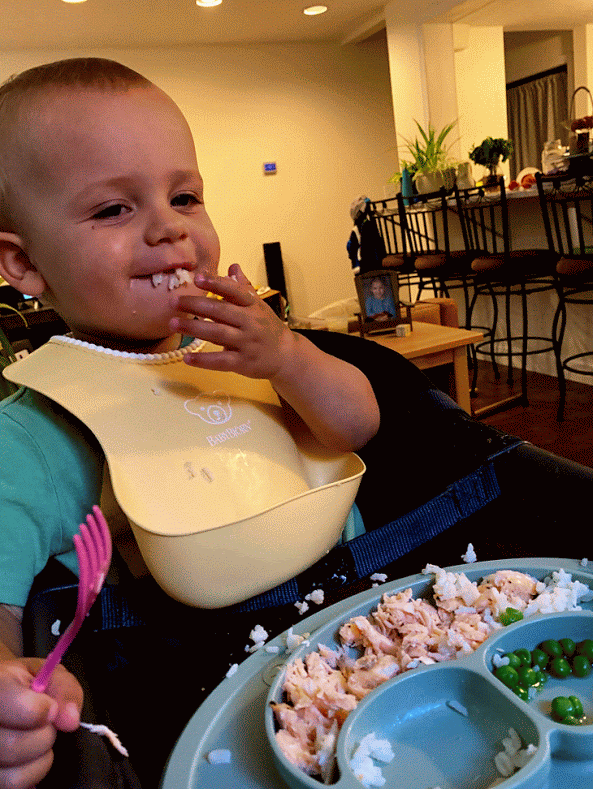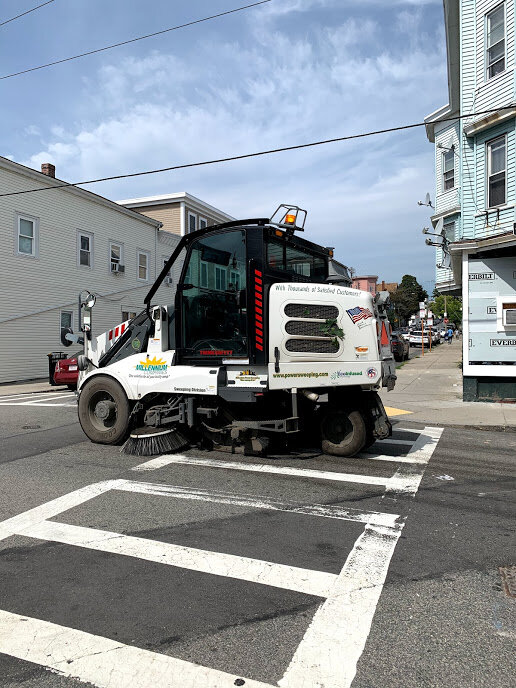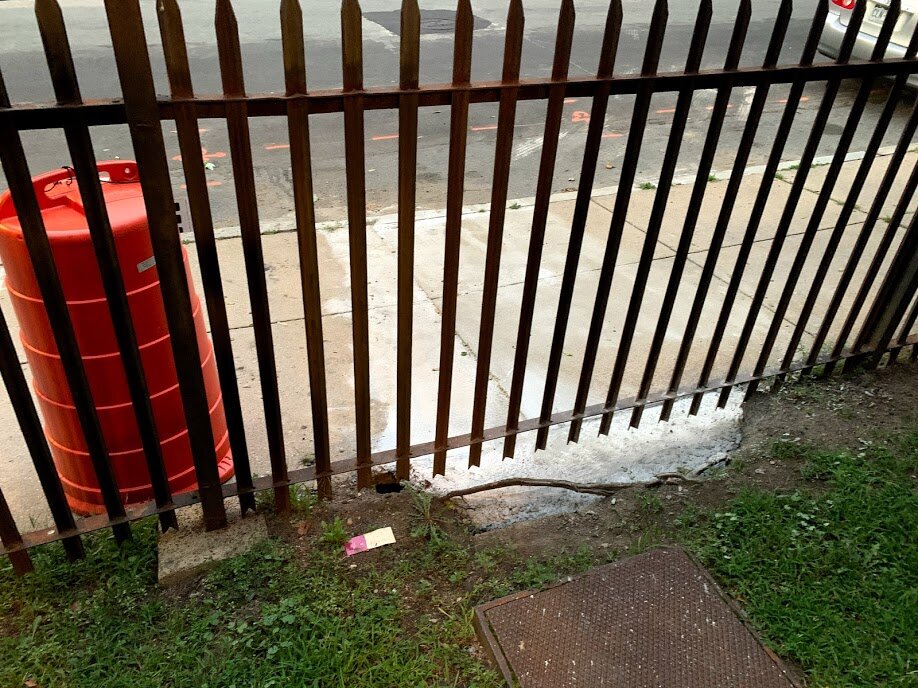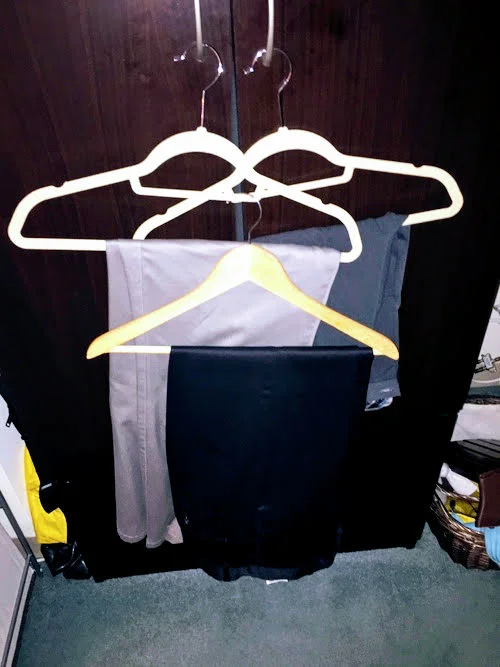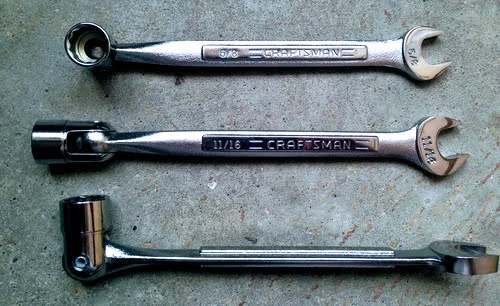It’s raining, and our two-year-old son Jack is standing behind his cheese stoop, watching through a curious set of eyes as the storm pours down and rattles its drops against the asphalt. We named the stoop back in January before COVID entered into our lives, and Jack stopped going to that place he knew as “school,” where his friends and teachers surrounded him with love while his parents worked. It was his routine ever since he was four-months-old, and ours as well.
For reference, a cheese stoop is a step or series of steps located inside or outside a home used by a toddler as a safe perch for the eating of cheese. Typically, this act of consumption is reserved for keeping the child distracted (and somewhat satisfied) while you rush to cook dinner after he transforms into a ferocious hangry monster demanding to be fed.
In our case, we have a small single step-stoop at the end of the kitchen that leads to the door. Open and pass through the door to the outside world, and you’ll find a concrete stoop, more of a platform than a step. On that outside stoop sits a black compost bucket, and atop that black compost bucket sits a hefty purple rock we found at a beach long before its duties ever included battening down a bucket from the wind.
When the sun is shining, Jack enjoys the simple pleasures of standing on the outside stoop and studiously inspecting the compost bucket with a keen eye. “Buckt. Purpel,” Jack will say. “Ruk. Biggg ruk,” nodding his head in agreement with himself and looking up at you with a big smile.
The rain is relentless, spattering its way through the open door and across the threshold of the stoop with little pitter-patters tap-dancing toward the little toddler happily munching on a fresh piece of American cheddar.
“Cheeez. Cheeez. Cheeez,” says Jack. Over and over and over again until we ask, “would you like some cheese?”
“Cheeeeez!” Jack replies with a smile. It is the only word he will say until a fresh slice reveals itself from the refrigerator, and he’s devouring it on his stoop like a predator protecting his meal.
The next thing he will say is, “More. One mo,” with a single finger waving through the air.
From the stoop, Jack has been watching the world move round (from the eyes of a child) since the beginning of the pandemic and his ongoing hiatus from daycare. One thing he loves even more than cheese is trucks. Big trucks. And although ours is just a little side street, set away from main roads and busy corridors, there is plenty to see if you have a comfy stoop and need to pass some time.
We’ve spent entire mornings watching as UPS and FedEx trucks shuffle up and down the road delivering packages. “Truk!” Jack will shout from inside the apartment at the sound of an engine, racing to the door or asking for a lift up to the window for a peak. “Mayelman!” He howls. Then there are the moving trucks. Not as consistent, but esteemed for their ability to remain stationary for long periods during which Jack doesn’t seem to get bored.
“Where is the truck, Jack?”
“There right there (no comma)!”
When asked where anything is, it is always “there right there.”
Back when the pandemic started, we experienced a bit of unintentional chaos at home. Oddly enough, not one out of the three of us had ever experienced a pandemic before. Nor had anyone ever worked full-time jobs while taking care of a child. And nor did the child ever have to be cared for by two busy parents not paying nearly enough attention to him.
We were all confounded.
As the parents, we never thought to establish or attempt to identify some sort of routine, some rules-of-the-day for sanity’s sake to usher us all forward safely, hour-by-hour until bedtime arrived and we could all breathe a sigh of relief.
It became apparent that we weren’t quite sure if Jack still needed two naps or was old enough to get by with an afternoon siesta — he seemed grumpy sometimes after breakfast. Would he happily eat lunch by himself while we typed away, scrambling to finish some work? How many snacks can we give him to stop crying before he would never eat a scheduled meal ever again? Is there a deeper psychological reason he keeps infiltrating the tea cabinet and dumping the bags out by the boxload? Why is he all of a sudden terrified of bathtime? When did he decide to stop liking every single type of food we know how to make?
Also relevant — why does 10:00 a.m. always feel like it should be at least 5 p.m.? And most importantly, are we all allowed to cry at the same time, as a family?
It turns out the answer is yes.
It wasn’t that neither of us wanted to or didn’t love spending so much time with Jack — quite the opposite — but aside from learning to build a brand new routine, the laptops, more often than not, felt like magnets propelling our bodies back at all times. It didn’t matter how far a walk you took, how many laps around the building you drove in Jack’s shiny red big-boy GT Mustang, or how nice and cozy you felt buried in a pile of books together on the bed. The laptops beckoned us back for more work … work … work.
Poor Jack was tossed between the two of us as we juggled sippy cups and snacks, laptops and earpieces, toy cars and stuffed animals, conference calls and laundry and brooms and more snacks and dirty diapers and bathtimes … all a bunch of spinning plates ready to come crashing down at any moment.
And sometimes things did come crashing down. But eventually, as time passed, we started new routines, and those routines changed again and evolved as Jack’s appetite for local exploration found us seeking out new adventures. A thousand moving parts as we all remained in place, in semi-quarantine lockdown with only our family walks around the neighborhood to escape. And so we counted our blessings, that we had jobs and shelter and food ... that we were safe.
Not to mention, we could all watch together as our family of three slowly turned into four.
Amanda’s belly was growing from a normal-sized belly into a bump. And then from a bump into a basketball. “Baybee,” Jack says while poking her in the belly/giggle button. He brings delicious snacks to that spot to see if he can somehow send a freeze-dried yogurt bite or a strawberry crispy chew through to the other side. “Snok,” he would say, nodding his head before giggling with Mommy in their secret squishy funny faces and shoveling the snok away for another yummy treat.
We made rainbows out of construction paper and put them on the windows with all his stuffed animals. His cardboard fort became a garage for his pushbike and toys. We read books on my belly and wrestled when we should have been napping or working or who knows what. We monitored the penguins and the sharks and the fish at the aquarium on the tablet screen.
Toes were tickled, and bellies poked. Amanda, my new and only co-worker, kept everyone fed, sane, and moving along toward whatever lay ahead in this strange and tumultuous inside-adventure. And Jack helped me clean — from dusting and brooming and Swiffering the floors to taking out the trash and learning to push the vacuum. He can even point at each of the houseplants that need watering.
For an assistant helper who gets paid in snoks, he does a pretty good job. And let’s not forget the laundry, his favorite task of all. With Mommy at his side, he throws in the dirty clothes one at a time, presses buttons, watches everything spin, and stands watch as the clothes spin round and round and round ….
We Zoomed and Facetimed with Nanas and Papas, Nonnas and Peppers, Voos and Aunties, and cousins too. Jack gave smooches and hugs, and of course, high-fives on the screen to anyone and everyone that needed a little bit of love or some virtual snuggles.
As we always did, Amanda and I would sneak into his room at night to watch him sleep for a few minutes. A cozy little lump of a boy with his blankies, bunny, and elephant. Somewhat oblivious to the daily mounting troubles of his country and this world. Peacefully snoring away while Amanda hides a collection of secret surprise binkies underneath the contents of the crib — her secret weapon for keeping Jack happy for a few extra minutes each morning while we sleep.
Together, we learned how to use our toddler backpack (“bckpck”) in which Jack could sit from a much higher perch than his cheese stoop, surveying the land and feeling the wind blow fresh air on his face and through his delicate strands of hair. A smile plastered and fastened securely in awe of the big wide world out there.
With our masks on, we marched our way through the airport grounds bordering our neighborhood, past the rental car center and the bus stations, then back across to the walking path along a small peninsula that pokes its way out into the harbor across from the city and past the fireboats and water taxis.
All deserted enough to feel safe, and a little like maybe we were playing bit roles in a post-apocalyptic zombie movie that was definitely not funny at all. Through the old shipyard and past the cider house, down the pier to the red Nantucket lightship. Continue by the park that sits across from the city and, at last, turn down the walking path back for home.
A nap time truly earned for everyone. Daddy, Mommy, Jack, and baby too.
The best days were Thursdays because Thursdays were street-sweeping days, and aside from cheese and trucks, Jack sure does love a nifty street-sweeper.
“Shhweep,” Jack says. Sometimes he could hear it a block over, and I would explain that it wasn’t quite here yet and that we had to change his smelly poo-poo first. He would slap his butt and nod while saying “pooh,” then run or slither or wriggle away out-of-reach and back to the stoop to keep an eye out for what his ears were telling him was something he just had to see. “Shhweep.”
Beyond the outdoor concrete stoop, there lies a small patch of grass followed by an old metal fence. The fence itself resembles a long line of rusty old spears thrust into the ground one-by-one to guard the space between us and the sidewalk. The grounds boast a rare city yard expanding beyond the walls of our corner apartment. The grass there is lightly decorated with a few large oaks that provide shade and shelter for the neighborhood bunny rabbits and squirrels — of which there are many, and all fearless city-dwellers, indeed.
“Treeee,” was one of his first words he used to say as we formed a new work-from-home childcare pandemic routine many months ago. Jack would stumble from the stoop to the yard through the rough up-and-down chunks of exposed roots to place his palm against the trunk and say, “hiiiiii, tree.”
Three trees.
Three stumbling walks.
Three hellos.
It was out there he started to walk. Then one day, he walked a little faster. And now he runs ... with arms pumping vigorously forward and back, palms facing toward the rear like he’s paddling the air with hand-like oars propelling him every step of the way.
From the outdoor stoop, Jack often points to the nearby unfilled hole-in-the-ground with equal parts located underneath the sidewalk and in the yard. Despite several attempts to reason with both the local government and the building managers, the hole remains a hole, and at that, a hole filled with trash — ergo, a trash hole.
Claiming that the hole originates from the building’s private yard, the city will only go so far as fastening a bright orange barrel to the fence along the sidewalk using a set of efficient-looking bungee cords.
I expect there must be a rulebook somewhere (created by a very professional committee) that very clearly states that when dealing with a hole not more than 50 percent on city property, the best that can be done is the fastening of a bright … orange … barrel. To warn the people, that is, of the dangerous hole, of course.
Standard procedure.
Although the entrance to the trash hole is located on our side and therefore sheltered from the street, it nevertheless finds plenty of trash to pile up, courtesy of its friend, the wind. In addition to random trash, Jack has witnessed both neighborhood bunny rabbits (“bunnee”) and cats (“moow”) emerge from the hole on several occasions. It is always a shock.
Mondays and Fridays are trash AND recycling days. This is important because the trash and recycle trucks are “big truks” and quite the newsworthy (and noisy) spectacles for a little toddler. The first run is always for the garbage cans — although few look like cans anymore. The city workers attack it with a quick pace, chucking the contents of the bins into the mouth of the monster that chews it all up. Jack watches as the chompers of the big truk take great delight in its constant feast, consuming garbage at an impressive rate.
Moving their way down the road in a methodical routine, the city workers put on a show that Jack will watch from as far as he can see in both directions. He won’t lose focus until the truck drives beyond the horizon, or around the corner, whichever comes first. He will then shake his head as if awakening from a hazy dream that couldn’t possibly have been real, except maybe it was. What was that thing?
Typically, it is considered rude, awkward, and not very nice to stare at someone from a short distance as they go about their professional work. But Jack loves trucks, and more importantly, he will cry if he doesn’t get to watch the action. And so, we watch the city workers, from an awkwardly short distance, as they go about their professional jobs in the midst of a global pandemic emptying trash bins. To show them we mean well, I spend my time convincing Jack to wave his hand at them in a gesture of good faith. I tell him, rather loudly, that he can wave hello to the nice men.
Of course, the nice men are very nice, and wave back at Jack and shout hello whenever he’s out there supervising from the stoop. “We’ll be back soon for the recycling,” they assure him.
A neighborhood is a funny thing. I imagine back in the day, they were all full of people who knew each other, shared meals and gossip, traded favors, and found friends. I’ve never really felt like that anywhere, but now with Jack … people see him, and they smile or laugh and say how cute he is. He’s a bridge to conversations I would have never had on my own.
There’s the smoking man who lives across the street. He has slicked-back hair, an enormous black SUV, and a wife with blonde hair who decorates their small lobby according to the next holiday. Jack and the slicked-back hair man often find themselves stooping it at the same time, one with a cigarette and the other with a piece of cheese — we all have our vices.
Jack now knows the sanitation workers, one UPS driver, most of our apartment building neighbors, and approximately forty-seven or so local dogs.
“What is that, Jack?”
“Dawgee.”
“What does it say?
“Woof, woof,” he replies, his tongue lapping.
We had never seen nor did we know the property-manager-lady across the street and next to the building of the slicked-back hair man. One day Jack was walking me around the sidewalk, and she happened to be taking in the garbage cans and recycling bins, a smile on her face.
“Is that my beautiful little boy?” She suddenly shouted from across the street. Do we know this woman? I asked myself. And then, “if you ever need anything, let me know, OK?”
Wow, what a friendly stranger she must be to offer another stranger potential future assistance with nothing in particular. “Thank you so much,” I shouted back. “Anytime, I mean it,” she went on, “I’ll leave you my number inside, in the mail slot.
Confusion began to set in. Mail slot. Why would she leave me her number in a mail slot across the street in a building I don’t have access to? And then, “does he want some chocolate chip cookies?” Not knowing what to say, I stuttered something that sounded like, “I’m not sure, maybe.”
The gears in my poorly functioning brain finally started to generate some power, and I realized this was a case of mistaken identity. Unless, of course, this woman schemed to lure in unsuspecting toddlers to her mailroom with the hope of chocolate chip cookies that may or may not exist.
“Oh, I’m sorry, do you think we live there?” I ask while pointing to her building. “Ahhh!” She gasps. I thought you were another baby. A couple just moved in. I’m sorry … you can still have a cookie, though!”
Stoops are good. Trucks are good. Lunches and snacks and the occasional Sesame Street binge are good. But the glue holding any halfway decent pandemic-quarantine-lockdown toddler routine is walks — lots of walks.
In March, Jack was still stumbling around, his hand held while canvassing his route across those exposed roots of his favorite trees. And so one of our favorite and, more importantly, time-consuming activities became our strolls along the secret airport walking paths at lunch.
With Jack in the stroller, the baby in the belly, and Mom and Dad at the helm, we entered the airport grounds each day from the west by the hotel nearest our apartment building and forging a path deep into a space we never thought to go before. It turned out that the walkable areas within the airport were an excellent place to stroll for many reasons.
First, it was immediately apparent that nobody else knew that the airport had a pleasant walking path. And second, there were plenty of buses around to make things interesting.
If there’s one thing Jack likes more than cheese and trucks, it’s buses. Boy-oh-boy does he like a good squeaky bus. While the airport was nearly void of life, the big blue electric shuttle buses maintained a regular schedule shuffling non-existent passengers from the Airport Train Station throughout the little city that lay within. So many buildings we never realized were there. A gas station. Parking lots for taxis and Ubers and Lyfts. A fire station, offices, and maintenance yards.
“Strowl,” Jack would say, following his second mid-morning snack or after lunch and before naptime. And off we would go, pausing often and any time a big blue bus or truck came barreling down the road.
Soon, Jack was not only a neighborhood regular but that little kid waving to all the bus drivers. And eventually, many of those bus drivers waved back at their little airport mascot cheering them on during what was otherwise a bizarre time for everyone. Jack would shout out to stop so he could concentrate on watching the buses fly by. As we strolled, he could see the tail fins of airplanes swimming around their bays, the bodies hidden by walls protecting the path from the runways and gates.
As the mom in charge and the parent with a real tip-top mind, Amanda knows most things. For instance, she knows before we arrive at a crosswalk what color the lights are from every direction. She knows who goes next and when the crosswalk sign will switch in our favor. She knows when buses arrive and their route numbers. When trains come and go and approximately how many minutes before the next one arrives. And so, as Jack and I mindlessly admire the vehicles, Amanda is methodically moving us like oblivious pieces of a chessboard across and over and through this new frontier according to her schedule. On and on we go.
There was one entire month that the Blue Line Subway Train shut down for maintenance. And although ridership was extremely low, the city contracted what seemed like a billion shiny Peter Pan buses to shuttle people around. While waiting their turn according to whatever schedule they followed, the buses parked in a lot right along our route.
During this time, buses appeared from everywhere and in all directions. They fell from the sky and dropped out of thin air. Jack could barely contain himself, often erupting in gasps and triumphant shouts of glory and glee. What a time to be alive, his tiny toddler brain would scream with excitement.
“There right there. There right there. There right there. Busss!”
But then, one day, and all of a sudden, arrived a smothering, soupy heatwave that never really went away. The meteorologists announced the official coming of what they referred to as a heat dome. It didn’t sound good. And so the strowls came to a screeching halt while we waited for the heat dome to subside.
Located near the trash-hole is a sewer grate. By all appearances, it looks and acts like a perfectly functioning sewer grate — granted, there’s not much for it to do most of the time. But whenever the rain pours down, rattling its drops against the asphalt, some type of invisible magical shield prevents the water from draining down that grate and into the sewer. Instead, a massive lake forms along the side of the road, rising up and up almost to the halfway point of the tires of the cars parked no more than a few feet from the outdoor concrete stoop.
With this minor flooding comes the local city sewer and water commission to investigate the mysterious magical shield. As our new routine dictates, if someone is working or trying to perform a professional-type job near the outdoor concrete stoop, we must observe them from a very short distance. And the city sewer and water commission would be no exception.
The commission workers arrive in only a measly pick-up truck, which isn’t bad, but given all the truk action around these parts, it is not the sort of thing that will captivate Jack’s attention for very long.
However, what if it was a pick-up truck with a crane attached to the bed? A crane that picks up sewer grates so city workers can inspect the drain for mysterious magical shield-like entities or an excess of unseasonal clumps of leaves?
Well, in that case, get me two snoks and a comfy stoop, because this is going to be good.
The man from the truck stood approximately eight to nine feet away from a grown man (me) and an almost-two-year-old (Jack) watching his every move as he uses the remote on the side of the vehicle to control the crane. The crane lowers a big metal hook carefully down until it clunk clunk clunks against the sewer grate. Taking some time to attach, the man raises the grate just enough to lay it safely down on the ground.
Wow! I can assure you Jack had never seen anything like that before. The nice man waves and smiles, and even inquires about the mysterious lake formation that is all the chatter these days in the neighborhood — but of course, the water was gone again.
The man could not detect any magical shield, nor did he find an unseasonal clump of leaves. The neighbors across the street gathered and watched, possibly wondering what was stuck in there, only to be disappointed that the mystery would not be solved that day.
Lucky for us, that meant more visits from pick-up trucks with cranes to remove the sewer grate near the trash-hole for inspection.
Eventually, the heat dome subsided to a slightly less overwhelming heat. And we learned that just as Jack could maintain a laser-like focus until his pleas for “cheez … cheez … cheez” were answered, that his requests for “woks oushide” could not be deflected until satisfied.
We put on the “sukz” and then the “shooz” and got the “sok.” The sukz are socks, and the sok is the soccer ball, which Jack excitedly, and with much enthusiasm in his fast-paced waddle, demands be brought on the wok.
Exploring the empty train station. Arms paddling.
All woks start in the yard with the sok. But for the most part, the sok is immediately thrown into the yard underneath one of the treeez and abandoned immediately.
We then amble over to the locked gate within the speared fence along the sidewalk. Once Jack has closed the gate and has my hand, we walk several yards to the building’s front steps. From there, we trapeze our way up the short flight of stairs back inside to the lobby and another set of steps leading to the mailroom.
Before you know it, Jack is galloping up and down the stairs on either side of the complex and racing his way through the halls. Occasionally, he stops to “nok” on a door or stand on a new “mat,” and since he can’t say “down,” everything, for now, is “up.”
Eventually, we make our way to the parking lot. Look both ways and cross the street, there you will find five sidewalk boxes filled with rocks and one single tree each. The wooden beams of the boxes provide a perfect challenge for balancing.
Saunter further up the slight hill, and the opening to the park welcomes you with its big black open gates. Hop onto the curb and walk in the tall grass at a height that almost makes a toddler feel four-feet tall. Look at the doggies that go woof in the park underneath the overpass. Then quickly run to the fence next to the three tiny pines. Plop down on the dirt-grass, and sit and watch as the metallic trains come barreling in and out of the tunnel like rumbling thunder, the vibrations felt from toe to head.
Pick up the pine cones, just the ones you need, and make a pile. Run back to the walking path and further into the park. Wave and say hello. Try not to hit anyone with pine cones. Make your way past the train tracks and the soccer fields and finally arrive at the bus and train station.
There you have found the source of those much beloved blue buses. The people are sparse, but be careful. Wander through the inside of the station when the trains rumble and choo-choo their way to the platform. But be alert and ready to run outside again as soon as another bus approaches. Back and forth you go until it’s time for dinner. If bathing suits are on, hit the splash pad and run through the spouts and sprays until you’re good and soaked. Then back to the path for the homeward journey.
A walk well done. Don’t forget the sok.
From March to September, all this time has passed, and while we’re mostly still sane, the world has changed. Jack has grown, the baby is coming, and we ramble on. A family of almost four, wondering if the pieces of our former lives will ever fit together like they once did. But probably they won’t, not exactly.
If there’s one thing we’ve learned while trying to keep Jack’s world intact, it’s that our much larger adult world isn’t working so well and that it took something enormous and terrible to shake everything to its core, pleading for changes to be made so that maybe a better world can take the place of the old.
And so, we’ve kept track of time not by counting the days or the weeks, but by tragedies and a blustering news cycle. But also by new words and routines, strolls and walks, and, of course, watching various forms of transportation.
We count the smiles behind the masks that Jack is responsible for all around the neighborhood. The ones we see from strangers or new friends whenever he waves his hand in the air and shouts “hiii!” It is a good number.
It makes me think that those smiles can’t help themselves, that they naturally form when witnessing cuteness and joy. And that sometimes, maybe that person remembers their child or niece or nephew or brother and sister, and what a special time that age was for them.
Dump trucks are particularly awesome. Junk trucks are OK. Crane trucks. Fire engines. Excavators. Cement mixers. And in a pinch, a pick-up truck will do just fine. Soon, Jack will return to daycare to his teachers and friends and start another new routine.
It’s not’s raining anymore. The day is bright, the sun shines down on the stoop, and the rain from the water has gone. Up along the sidewalk putters the truck with the crane in the bed to investigate.
“Jack, where is the truk?”
“There right there,” he points and then breaks into a paddling sprint back to the stoop and the open door while squishing the inside of his face inward to form a double chin, his tongue wagging in concentration.
He looks back at Amanda as she makes dinner.
“Cheeez?”
Ironically, after almost two-and-a-half years living here, the city actually filled up the trash-hole just as I finished writing this story. My only regret is that I never took a better picture of it during its glory days.


